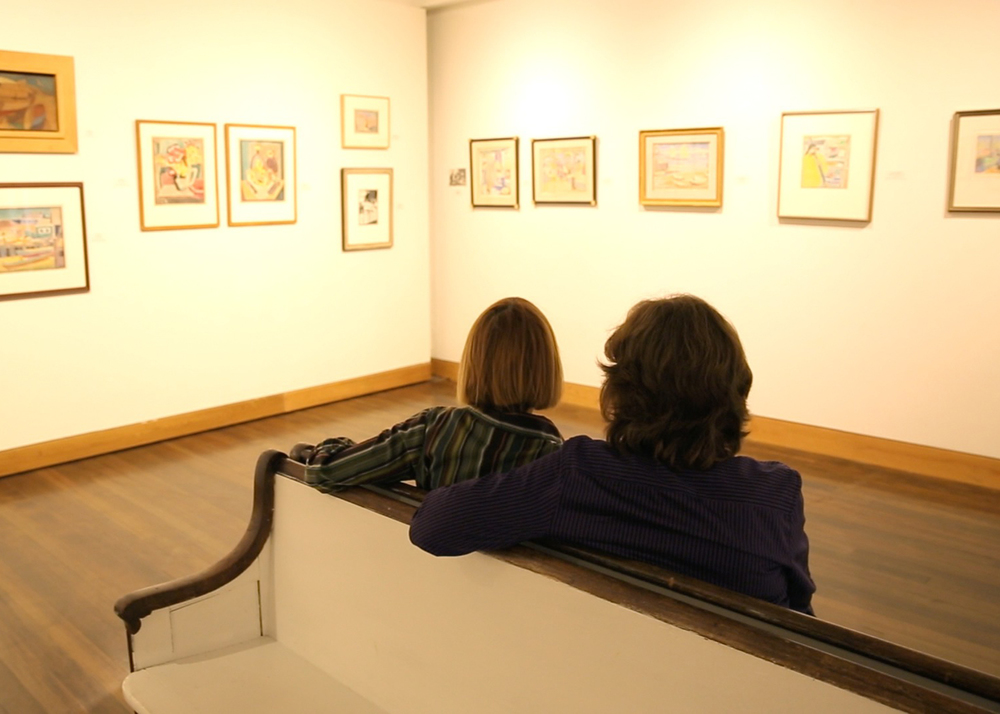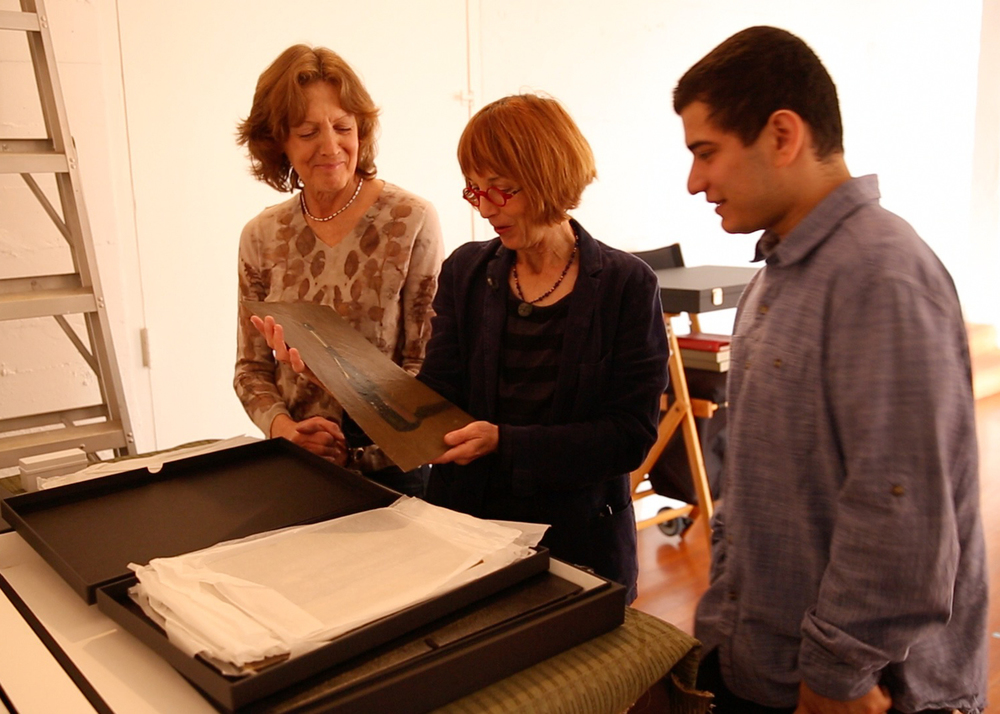“The documentary is about righting a terrible wrong in someone’s life. It’s about redeeming someone who was victimized in their day and giving them a better ending to their story.”
It’s become a cliche that after years and years of painstakingly honing their craft, artists are only discovered after death. But for artist Edith Lake Wilkinson, that cliche is her truth. After 30 years of painting and traveling, in 1924, Edith was diagnosed with “paranoia” and sent to the Sheppard Pratt Hospital in Baltimore. Her art was then sent to her only living relative, a young nephew, who kept the work packed away in a set of trunks. Edith’s life was one of turmoil, unable to openly be with the woman she loved. Moreover, there isn’t much mention of her or her art in Provincetown, Massachusetts where she predominantly painted. That is, until her great-niece, Emmy Award-winning writer Jane Anderson(“Olive Kitteridge”) came along, adamant that Edith’s story be told. And thus, the HBO documentary, “Packed in a Trunk: The Lost Art of Edith Lake Wilkinson” was born.
“Packed in a Trunk” follows Jane and her wife Tess as they travel the United States to learn more about Jane’s great-aunt Edith, whose art decorated her family’s home since she was a little girl. Not much is known about Edith’s life except that she left her family’s home in Wheeling, West Virginia at the age of twenty to travel to New York City where she met Fannie, a woman she would live with for the next twenty years. Edith studied art in New York, Europe, and most notably, in Provincetown, Massachusetts, as part of the artist community that popularized the white-line woodcut technique. Sadly, in 1924, Edith’s family attorney committed her to an asylum where she lived out the remainder of her life, without Fannie and without art.
The Workprint’s Jen Stayrook had the opportunity to sit down with Jane Anderson to discuss the film and the journey of discovering more about Edith Lake Wilkinson’s art and life.
Jen: You’ve been chasing Edith’s ghost for almost 40 years. Why was this story important for you to tell not just to yourself but to the world?
Jane: I didn’t do this documentary for myself. This documentary isn’t part of my career or for my resume. I did it strictly to find some justice for Edith. I found the documentary form is the best tool to get Edith’s work out there to find museums and collectors who would want to take her over after I get old and gray and finally kick. I’m 60 now and I’ve many years to go but at this age you start thinking, “Where is all my stuff gonna go?” I don’t want Edith’s work and legacy to go back into the trunk after I’m gone. That’s why I thought this documentary would help get her out there and keep her name alive.
How important was it for you to go on this journey with Tess?
Well, we’ve been together for 33 years and she lives with the art. She has talents that I don’t have–her research talents, her ability to follow-up on things. I have this knack for starting a project and then wanting everyone else to fill in the details. Tess, in a way, represents for me and for Edith, the life that Edith should have had, with the ability to live openly as a gay woman, to have a healthy relationship. Our director Michelle, on a narrative level, wanted Tess there. I’m used to being behind the camera, writing and directing, so I wasn’t particularly eager to be filmed all the time and get hooked up with the mic and have a big lens in my face. However, it became clear to all of us, in order for this documentary to have any kind of story, it needed to be told through me and my connection to Edith. If it were just a documentary about Edith it would be a really sad film because she ended up locked away. My involvement as a character makes this a victorious tale because I was able to get her work back to Provincetown.
This documentary is full of so many “coincidences” that it’s hard as an outsider not to see it as more than such. The marketplace she painted that becomes the Larkin art gallery she’s eventually featured in, the similarities between her life in yours, the Joan of Arc book–did you start to feel like at some point that someone was playing a trick on you with all of this or did it really just feel like, well, fate?
It was so crazy and what we didn’t put in the film was at the same time we were doing the filming I was working on my new play which is about Joan of Arc’s mother, called Mother of the Maid. The fact that Joan of Arc has been popping up in my life and then again with Edith, I was gobsmacked.
Why is the Joan of Arc book significant to you and why do you think it was significant for Edith and Fannie?
For Edith, I think judging from the fact that Fannie gave it to her for Christmas, it was probably a first Christmas present, and that book illustrator was a well-known French artist; they’re gorgeous pictures. At the time, I think that Fannie thought Edith would love these pictures as an artist. I’m not sure what Edith’s notion was with Joan of Arc. The fact that Edith, as a post-Victorian young girl, went from Wheeling, WV to NYC to become an artist signifies that she had a fire in her, a sense of independence, because girls in 1899 didn’t do that. You stayed at home and did needlework, got married, stayed close to your parents. That was a huge move. I moved from northern California to New York when I was 20, so I think Joan is an icon of going out on your own and doing great heroic things with your life. I don’t know if she had a deep connection with Joan, but I always did.
How does it feel to be releasing this documentary on the heels of the federal government legalizing same-sex marriage?
Barb, Michelle, Tess, and I were at the Frameline Film Festival in San Francisco and the theatres there are smack in the middle of the Castro. We were there the weekend the ruling came down and it was one of the heaviest experiences I’ve ever had as a gay person. God knows what Edith would have thought. I kept asking people, “Do you think Fannie and Edith would have gotten married? If they could have gotten married, would that have changed the way they viewed each other?”
Did you ever consider delving into Fannie’s life to learn more about Edith? Maybe to find if Fannie ever kept any of Edith’s work?
Tess tried to find Fannie’s family. She grew up in Augusta, GA. After the civil war, her father moved her family to Brooklyn where they were very well off. We hired a great researcher in New York but we only could find out so much about her before the trail went cold. Tess tried to contact her family, I think a great-niece, but never heard back. We’re hoping with the release of the film on HBO that maybe someone out there who remembers great-aunt Fannie and will contact us so we can find out a little more.
Do you think Edith’s short career is why she isn’t mentioned alongside Blanche Lazzell and Ada Gilmore? Or do you have any guesses as to why?
I’m sure you have circles of fellow writers or artists and if someone moves away, they fall out of touch. This was before the internet–you could write letters back and forth, but that was it. I think artists are kind of like cats. Out of sight, out of mind. Back then I think people didn’t want to have anything to do with the friend who had supposedly gone a little nuts. I would guess the artist community sympathized with Edith and then went on with their lives. Mental health has always been something that makes people nervous. Thankfully, I think we’re all much more compassionate in 2015 in dealing with nervous breakdowns and depression and bipolarism.
Because Edith never “needed” the money, living off her family’s inheritance, do you think that’s why not many came across her work? She didn’t need to sell the art to survive, so she hoarded it for showing at galleries as well as sentimental value.
Oh, that’s a really interesting theory. I think that is possible. Blanche Lazzell got support from one of her big brothers but mostly she was selling flowers seeds and her prints to survive. I’ll tell you, when I went to Provincetown and the art collector told me he had never ever seen an Edith I just thought, “How can that be?”
I’m going to confess to you a spooky dream I had three nights ago. I dreamed that someone had found a whole bunch of Ediths and I saw some of them clearly in the dream. One of them was a long horizontal board where she painted kids, and on the other side she had painted “Pearl Street.” In the morning I put Pearl Street, Provincetown into Google, just to see if it existed and a pin dropped on Pearl Street right on a house that a woman named Nelly Barnes lived in back then. Nelly fed artists back then and I think that Edith was a buddy of hers. I emailed all of my friends in Provincetown and asked if they thought there might be paintings there. One of them gave me the phone number of the house and I haven’t called them yet.
OH MY GOODNESS WHY NOT.
What do I say? “Oh, I had a dream…Are there paintings in your house?” Or do I say, “I’m Jane Anderson from HBO, blah blah blah.”
No, no, no. You say, “I have a friend who’s kind of a little crazy and she had a dream that there might be some Edith paintings in your house. I’m just calling on her behalf to placate her, so do you happen to have any paintings lying about, maybe in your attic? Perhaps inside some trunks?”
Ooohhhhh a friend. I was going about this all the wrong way. Instead, I keep making that call and then immediately hanging up.

What is it that you most want people to know about Edith?
Her brilliance as a painter, the joy and color in her work; her craft was exquisite. I just want people to know her as a talented and remarkable artist. My hope is that this documentary adds her to the canon. It’s not like I have thousands of pieces of work, not like the major artists like John Singer Sargent or even Van Gogh. She won’t make an enormous splash but I think it’s important for anybody out there who knows of an artist who has been forgotten and that her discovery will encourage that dialogue to get those forgotten artists’ work back out there.
I had to do this for Edith because she’s an unknown genius. She needed an advocate because there was no one there who understood her or stood up for her or who was going to pull her out of the asylum and get her painting again. No one did that for her so I’m doing that for her postmortem.
“Packed in a Trunk: The Lost Art of Edith Lake Wilkinson” airs tonight, July 20th, on HBO at 9PM EST.


I want to say something ……..there are no words to express how this documentary made me feel.Amazed,excited,angry,sad.I guess in the end I’m GRATEFUL for the generosity of Mz.E.L.Wilkinson’s Grandniece for sharing the story and the work.
Thank you.